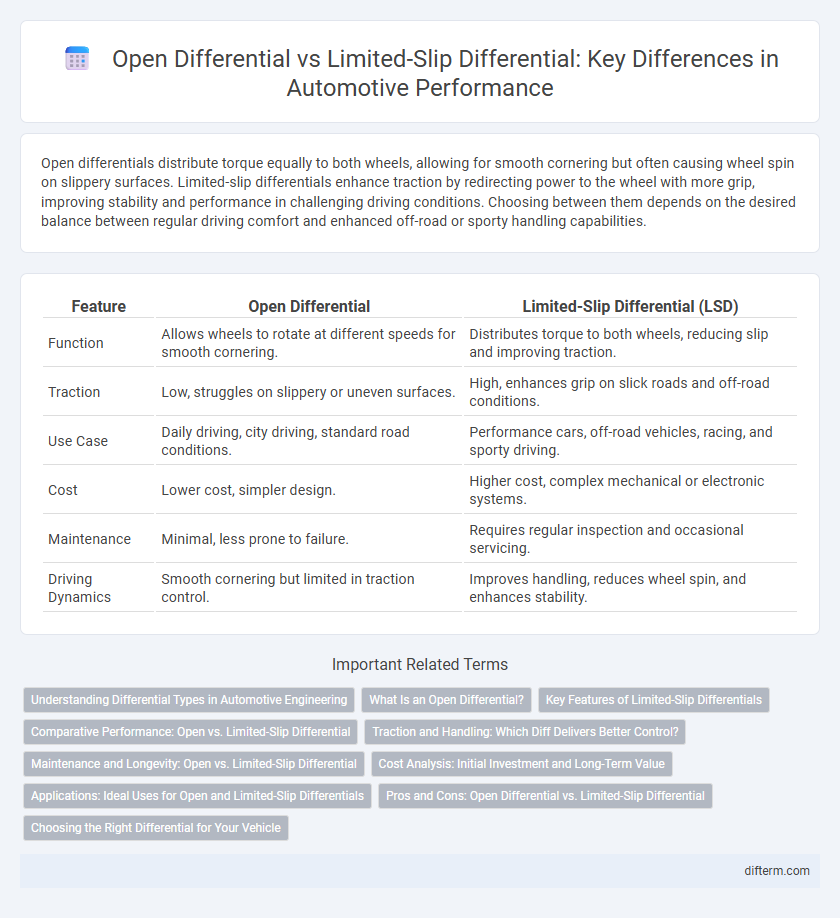Open differentials distribute torque equally to both wheels, allowing for smooth cornering but often causing wheel spin on slippery surfaces. Limited-slip differentials enhance traction by redirecting power to the wheel with more grip, improving stability and performance in challenging driving conditions. Choosing between them depends on the desired balance between regular driving comfort and enhanced off-road or sporty handling capabilities.
Table of Comparison
| Feature | Open Differential | Limited-Slip Differential (LSD) |
|---|---|---|
| Function | Allows wheels to rotate at different speeds for smooth cornering. | Distributes torque to both wheels, reducing slip and improving traction. |
| Traction | Low, struggles on slippery or uneven surfaces. | High, enhances grip on slick roads and off-road conditions. |
| Use Case | Daily driving, city driving, standard road conditions. | Performance cars, off-road vehicles, racing, and sporty driving. |
| Cost | Lower cost, simpler design. | Higher cost, complex mechanical or electronic systems. |
| Maintenance | Minimal, less prone to failure. | Requires regular inspection and occasional servicing. |
| Driving Dynamics | Smooth cornering but limited in traction control. | Improves handling, reduces wheel spin, and enhances stability. |
Understanding Differential Types in Automotive Engineering
Open differentials allow wheels to rotate at different speeds, essential for smooth cornering but often resulting in reduced traction under low-grip conditions. Limited-slip differentials (LSD) enhance traction by distributing torque to the wheel with more grip, improving vehicle stability and performance, especially in high-power or off-road vehicles. Understanding these differential types is crucial for optimizing drivetrain efficiency, handling dynamics, and vehicle control in various driving environments.
What Is an Open Differential?
An open differential allows the wheels to rotate at different speeds, especially crucial when turning corners, by distributing torque equally but independently to each wheel. It provides smooth handling on dry roads but struggles with traction in low-grip conditions, as power is sent to the wheel with less resistance. This type of differential is commonly found in standard passenger vehicles due to its simplicity and cost-effectiveness.
Key Features of Limited-Slip Differentials
Limited-slip differentials (LSD) enhance traction by distributing torque to the wheel with the most grip, preventing wheel spin during acceleration or cornering. Key features include improved handling on slippery surfaces, reduced understeer, and enhanced power delivery to the wheels compared to open differentials, which allow unlimited speed difference between wheels. LSDs offer better stability and control in performance and off-road vehicles by actively managing torque distribution.
Comparative Performance: Open vs. Limited-Slip Differential
Limited-slip differentials (LSD) improve traction by distributing torque between wheels more effectively than open differentials, especially during cornering or on slippery surfaces. Open differentials send power to the wheel with the least resistance, often causing wheel spin in low-traction scenarios, while LSD reduces slip by transferring torque to the wheel with better grip. In performance driving and off-road conditions, LSD provides superior stability, handling, and acceleration compared to open differentials.
Traction and Handling: Which Diff Delivers Better Control?
Limited-slip differentials significantly enhance traction by distributing torque more effectively to wheels with grip, improving handling on slippery or uneven surfaces. Open differentials, while simpler and less expensive, allow one wheel to spin freely when traction is lost, reducing overall control in adverse conditions. For superior control and stability, especially during cornering or off-road driving, limited-slip differentials provide a clear advantage in both traction and handling performance.
Maintenance and Longevity: Open vs. Limited-Slip Differential
Open differentials require minimal maintenance but can suffer from uneven tire wear and reduced traction over time, impacting overall durability. Limited-slip differentials, while more complex, benefit from periodic fluid changes and careful inspection of clutch packs or viscous couplings to ensure optimal performance and extended lifespan. Proper maintenance of a limited-slip differential significantly enhances vehicle handling and longevity compared to the more basic open differential design.
Cost Analysis: Initial Investment and Long-Term Value
Open differentials typically have a lower initial cost, making them a budget-friendly choice for everyday vehicles, but their lack of traction control can lead to increased tire wear and potential drivetrain damage over time. Limited-slip differentials require a higher upfront investment due to their complex mechanical design, yet they enhance vehicle stability and performance, potentially lowering long-term maintenance and repair expenses. Evaluating the total cost of ownership reveals that limited-slip differentials may offer better long-term value for high-performance or off-road vehicles despite their higher initial price.
Applications: Ideal Uses for Open and Limited-Slip Differentials
Open differentials are ideal for everyday driving scenarios where smooth handling and ease of turning are prioritized, such as city commuting and highway cruising on dry pavement. Limited-slip differentials excel in performance and off-road applications by providing enhanced traction during cornering and on slippery surfaces, making them perfect for sports cars, rally vehicles, and off-road trucks. The choice between open and limited-slip differentials depends heavily on the vehicle's intended use, road conditions, and driving style preferences.
Pros and Cons: Open Differential vs. Limited-Slip Differential
Open differentials provide smooth operation and ease of maintenance but struggle with traction since they send power to the wheel with the least grip. Limited-slip differentials enhance vehicle stability and cornering performance by distributing torque more effectively between wheels, reducing wheel spin under load. However, LSDs can be more complex, heavier, and costly, requiring more frequent maintenance compared to open differentials.
Choosing the Right Differential for Your Vehicle
Selecting the ideal differential for your vehicle depends on driving conditions and performance goals. Open differentials provide smooth handling in everyday driving by allowing wheels to rotate at different speeds, enhancing traction on regular roads. Limited-slip differentials improve grip and control in high-performance or off-road scenarios by distributing torque to the wheel with more traction, preventing wheel spin during acceleration or cornering.
open diff vs limited-slip diff Infographic

 difterm.com
difterm.com